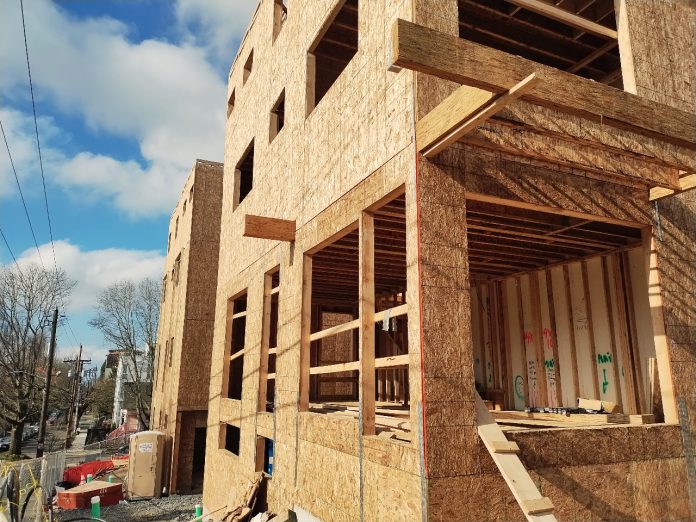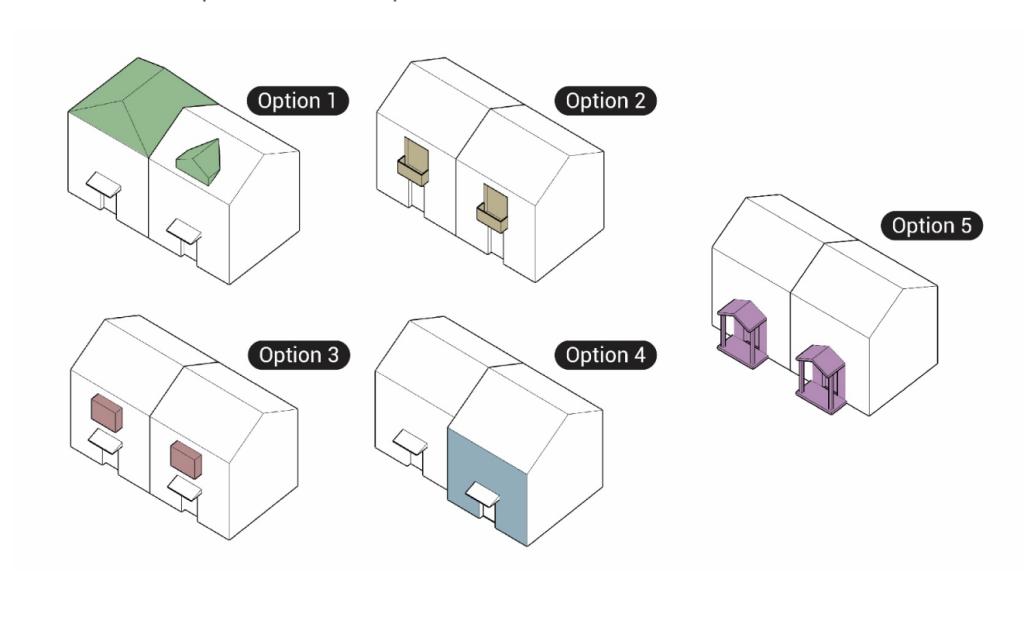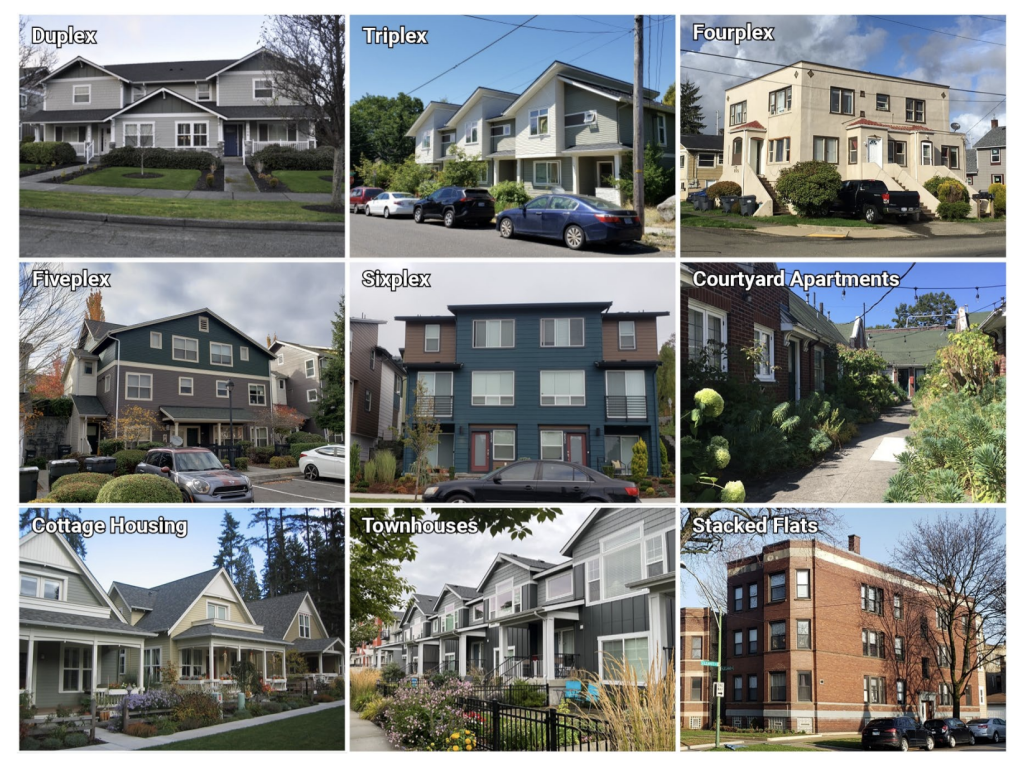
The state responded to urbanist feedback by finetuning its draft model code for middle housing to allow homebuilders more flexibility.
The Washington State Department of Commerce has published the final version of its middle housing model codes and guidance documents. It’s an important step in implementing House Bill 1110, the “missing middle” housing law passed by the state legislature last year that will encourage multiplex development in place of single-family neighborhoods.
The model codes will be used in communities that fail to comply with the middle housing law by state-mandated deadlines. Though not all cities in the state will have to implement HB 1110, most will need to do so this decade. The first round of cities subject to the law will be in King, Pierce, Snohomish, and Kitsap Counties with compliance required by July of 2025.
Why do city tiers matter and has much changed?
As a short primer, HB 1110 will apply differently to cities depending upon on their size and context. The law essentially established three tiers of cities, with Tier 1 cities having the highest middle housing density requirements and Tier 3 cities having the least.
Tier 1 cities are defined as having a population of at least 75,000 residents while Tier 2 cities have a population between 25,000 and 75,000, and Tier 3 cities have a population of less than 25,000 residents but are located in a county with a population of at least 275,000 residents and are situated in a contiguous urban growth area with the largest city in the county — such as the smaller suburbs of Seattle within King County.
The bulk of the model codes remain unchanged since the draft issued in November, but Commerce did respond to public and stakeholder feedback by making notable changes, particularly around more generous rules around lot coverage, floor area ratio, setbacks, and design standards. Commerce also provided more clarity around development standards and offered more local policy choice guidance. That additional guidance generally encourages cities to provide more flexibility, housing options, and development capacity.
What stayed the same in the model codes?
In brief, the following development standards generally remain the same in the model codes unless otherwise noted:
| Standard | Tier 1 | Tier 2 | Tier 3 |
|---|---|---|---|
| Middle Housing Types1 | Modified | Same as Tier 1 | At least 4 of 9 types of middle housing |
| Base Density | 4 homes per lot2 | 2 homes per lot2 | 2 homes per lot |
| Density Bonus | 6 homes per lot when near major transit or 2 homes are affordable2 | 4 homes per lot when near major transit or 1 home is affordable2 | N/A |
| Floor Area Ratio (FAR) Limit Minimums | Modified | Same as Tier 1 | N/A |
| Lot Coverage Limit Minimums | Modified | Same as Tier 1 | 40% |
| Setback Maximums | Street or front: 15 feet, except 10 feet for lots with 3 or more homes and 20 feet for garage doors Side street: Modified Side interior: 5 feet, except 0 feet for attached homes Rear: 15 feet, except 10 feet for lots with 3 or more homes Exceptions for projections: 5 feet into front and rear setbacks for covered porches and entries, and 3 feet into front and rear setbacks for balconies and bay windows | Same as Tier 1 | Street or front: Modified Side street: 5 feet Side interior: 5 feet, except 0 feet for attached homes Rear: 20 feet Exceptions for projections: 5 feet into front and rear setbacks for covered porches and entries, and 3 feet into front and rear setbacks for balconies and bay windows |
| Height Limit Minimums | 35 feet | Same as Tier 1 | Same as Tier 1 |
| Maximum Parking Mandates3 | Within 0.5 miles walking distance of major transit stop: 0 stalls per unit On lots smaller than 6,000 square feet: 1 stall per unit On lots larger than 6,000 square feet: 2 stalls per unit | Same as Tier 1 | Same as Tier 1 |
2. The density requirements don’t apply to lots after subdivision below 1,000 square feet unless the city has a law allowing lot sizes below 1,000 square feet.
3. The maximum parking mandates don’t apply if certain studies are conducted by a city to demonstrate a need for parking or in portions of a city within 1 mile of Seattle-Tacoma International Airport.
What changed in the model codes?
In the model codes, Commerce made the following changes to development standards for Tier 1 and 2 cities:
- While the statutory requirements only require Tier 1 and 2 cities to allow six of nine types of middle housing, the model code will allow all nine. In other words, not adopting a code of their own will prompt cities to automatically allow more types of housing.
- Maximum floor area ratio was tailored to unit counts and adjusted upward with 0.6 for one unit, 0.8 for two units, 1.0 for three units, 1.2 for four units, 1.4 for five units, and 1.6 for six units. The previous iteration ranged from 0.6 to 1.2. The updated floor area ratio regulations also clarify how to measure the standard and generally exempt basements, unenclosed features (e.g., balconies, carports, and rooftop decks), and accessory structures up to 250 square feet per unit.
- Maximum lot coverage was adjusted upward, with 45% for lots with three or fewer units, 50% for lots with four or five units, and 55% for lots with six units. The previous iteration ranged 45% to 50%. The updated lot coverage regulations also clarify what counts as lot coverage, which is generally just a structure’s footprint, not minor attachments and projections.
- Setback changes were a bit mixed with side street setbacks becoming universally five feet (previously allowed zero-lot-line setback for attached units), alley setbacks becoming zero-lot-line except for a three-foot setback from garage doors, and new allowances for required parking spaces to be located within required setbacks.
For Tier 3 cities, the only substantive changes beyond design standards were setbacks, which went in a similar direction as a Tier 1 and 2 cities. Setback changes for street or front setbacks went from 20 feet to 15 feet with an exception for 10 feet when lots have at three units (through garage doors are still 20 feet), alley setbacks became zero-lot-line except that a three-foot setback applies for garage doors, and new allowances were added for required parking spaces to be located within required setbacks.

For Tier 1, 2, and 3 cities, the design standards in the model codes were adjusted as follows:
- Unit articulation standards have been entirely discarded as a requirement in the model code, instead solely provided as local policy choice guidance.
- Tree requirements were essentially eliminated and instead a landscaping standard was added to note that landscaping and tree requirements for middle housing cannot be more restrictive than the requirements for detached single-family residences.
- General standards around building entries as well as windows and doors were eliminated for Tier 1 and 2 cities, but remain for Tier 3 cities.
Finally, model provisions around unit lot subdivisions were entirely removed from the model codes, eliminating a mandatory framework for cities not in compliance with HB 1110. This language was instead incorporated as a local policy choice, though HB 1110-compliant cities will have to allow unit lot subdivisions for middle housing in some form. Compliant or not, cities poised to start seeing middle housing would do well to adopt flexible unit lot subdivision provisions. That’s because unit lots provide a fee simple form of property ownership, which is more readily financeable with loans than condominium forms of property ownership.
In the next year or so, we’ll begin to get an idea on which cities may be headed for deference to the model codes instead of their own HB 1110-compliant middle housing codes. It’s not likely to be many, but there could be some cities that fall behind in completing their mandatory comprehensive plan updates, fail to get an implementation timeline extension from Commerce, or otherwise fail to reach an agreement on regulations that they want to impose and comport with the middle housing law. But for now, the model codes and guidance are complete, offering a good benchmark and useful insight for cities to develop their own regulations to meet the spirit and letter of the middle housing law.
Stephen is a professional urban planner in Puget Sound with a passion for sustainable, livable, and diverse cities. He is especially interested in how policies, regulations, and programs can promote positive outcomes for communities. With stints in great cities like Bellingham and Cork, Stephen currently lives in Seattle. He primarily covers land use and transportation issues and has been with The Urbanist since 2014.


